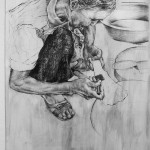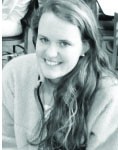Author: Phoebe Christine Bush
Softball starts out strong, aims to qualify for national tournament
By Graham Lucas
Transcript Correspondent
For most students, spring break was an opportunity to see relatives or live out an absurd MTV born fantasy in Cabo, but OWU softball spent their break accumulating a 7-3 record and a third place ranking in the NCAC.
Softball’s season began in both Fort Meyers and Cape Coral, FL where they played their first ten games. The 7-3 start is their best since 2011. Senior Amanda Barker said their trip to Florida “boosted the team’s confidence and helped realize what they are capable of.”
Barker, along with junior Danielle Haley, were large contributors to the team’s success in Florida. Barker, a pitcher, is currently 5-0 with a 1.05 earned run average, while Haley has a 1.20 ERA giving the Lady Bishops the lowest ERA in the conference. Barker’s efforts in Florida earned her NCAC pitcher of the week. Haley said she and Barker work in conjunction, not in competition.
“Amanda (Barker) and I feed off of each other’s confidence and work very well together,” Haley said. “If I’m doing something wrong she is the one to help me with my pitching and I do the same for her. Most people compete to play over each other but we encourage each other and want the one another to be successful.”
Senior Brooke Nethers is batting a team best .469 with 15 hits on 32 plate appearances. Nethers’ batting average has also earned her fourth place in the statistic in the NCAC. Nethers said she owes her achievements to her teammates.
“My batting average is where it is because of the hard work my teammates and I have put in during the indoor portion of our season,” Nethers said. “Our offensive practices are very focused and intense, and without these and the help of my teammates my batting average would not be as high as it is now.”
A young contributor to softball’s start is freshman Sarah Flint. Flint, a Westerville, OH native, has accumulated a team-high 11 runs batted in. She said her RBI’s can be attributed to her place in battling line-up and her teammates.
“I believe my spot in the batting line-up definitely improves my chances for RBI’s,” Flint said. “Because of my teammates’ success at the plate they are almost always on base when I come up to bat. They have worked hard to get on, so I want that hard work to pay off.”
The team went 14-22 in last year’s campaign, “a tough season” that they are looking to grow from, said Haley. They were also bounced by Allegheny in the first round of the NCAC tournament. Nethers said in order for them to be more successful than last year, the seniors need to lead.
“Senior leadership is the kind of thing that sets the stage for the whole team’s attitude towards every aspect of the game,” Nethers said. “This year our senior class is full of a bunch of diverse individuals who all bring something great to the team. I think that this is a major reason as to why we are successful thus far and will continue to be in the future.”
The Lady Bishops have yet to play a game since spring break due to lingering winter weather. They begin conference play at Wittenberg Saturday, March 30. Nethers said with the team hitting on all cylinders, anything is possible.
“Our potential this season is limitless,” Nethers said. “Our hitting is only going to get better as we see more and more live pitching. All of our pitchers are phenomenal and only continue to grow. We hope to end up playing in the national tournament and if things continue going the way they are, that is completely possible.”
Freshman swimmer breaks school and personal records at nationals
By Marilyn Baer
Transcript Reporter
Freshman swimmer Jessica Ward received 13th place and honorable mention All-America status last weekend at the NCAA swimming and diving national championship in Shenandoah, Texas.
This is the first time since 1994 that a Bishops women’s swimmer has earned multiple All-America honors at a single championship meet.
Ward competed in the 100-yard backstroke, the 200-yard backstroke and the 200-yard individual medley.
“I was super nervous for each event, especially the 100 back because that is my event,” Ward said.
Her nerves were relieved by her fellow teammates, however.
“The whole time I was at nationals all my teammates were texting me and wishing me good luck and they were cheering for me,” Ward said. “Knowing that they were there supporting me the whole time helped take away a lot of the nerves because I didn’t feel like I was doing this alone.”
In the 100 backstroke preliminary, Ward beat her previous school record with a time of :55.58 and advanced to the finals where she won fifth place and All-American status, with a time of :55.87.
Ward placed fifth in the 200-backstroke consolation final finishing in 2:02.80, which was within :00.5 of her best time.
In the 200 Individual Medleys her time of 2:09.00 eclipsed the school record of 2:10.93 set in 1992 which she said is a “personal best.”
However her time in the Individual Medleys did not qualify her for the event finals.
Head coach Richard Hawes believes Ward’s performance at the meet was “excellent.”
“As a freshman, she showed great poise, staying composed and performing at her very best at such a highly competitive event,” Hawes said. “I am very proud of her.”
Ward has been swimming since she was eight years old and said she has a vigorous training schedule.
“Over the year I practiced Monday through Thursday in the morning and then every day during our normal practice,” Ward said. “The morning practices were only 2,000-3,000 yards while our regular practices are normally double that.”
Ward said 20 minutes before each race she warms up and then waits. While waiting she mentally prepares by listening to music.
“I like to listen to the song One Way Or Another (Teenage Kicks) by One Direction,” Ward said. “When I swim backstroke I have a certain rhythm and this song has the same rhythm, so it helps me get the right tempo.”
Ward said she left the NCAA Championship meet with no regrets.
“I had two goals going into the season, one, go a :55 in my 100 back and two, go to nationals,” Ward said. “I met both my goals, so I would not have done anything differently.”
Ward said that this season’s victories couldn’t have been achieved alone.
“I do want to add though that a huge part of how this season went is due to the fact that Richard Hawes is an amazing coach and that I have such a great team,” Ward said.
She attributes hard work, positivity and confidence to her early successes as swimmer.
“I believe in myself,” Ward said. “I try and avoid negative thoughts and I try to not think things like I’m not fast enough etc. because I am fast enough and it’s those kinds of negative thoughts that keep people from reaching their goals. You just have to be confident in yourself. Being confident is not being cocky or stuck up its knowing who you are and what you’re capable of. I know who I am, I know what I’m capable of and I know I have to work hard to reach my full potential.”
Winters receives national and regional recognition for basketball performance
By Heather Kuch
Sports Editor
Although the Ohio Wesleyan men’s basketball season ended two weeks ago, senior point guard Andy Winters continues to receive honors for his play this season.
Winters was named to the National Association of Basketball Coaches (NABC) All-America first team, was named Great Lakes District Player of the Year and was a first-team All-Great Lakes District selection by the NABC.
Additionally, he was a first-team All-Great Lakes Region selection, a Great Lakes Region Player of the Year, a North Coast Athletic Conference (NCAC) first-team selection, and was named NCAC Player of the Year.
Winters said he felt honored to receive these awards and said his teammates and coaching staff played a key role in his achievements.
“I know the amount of talent in the Great Lakes Region and I can’t thank Coach DeWitt enough because he made it possible for me to prove myself,” he said. “Going into the games I had so much confidence in my team that I knew if I just went out and played as hard as I could each game, good things would happen not only for me, but for our team.”
Senior Greg White, a member of the men’s basketball team, said he was proud of his teammate’s achievements this season.
“Andy receiving these awards really shows how far this program has come,” he said. “He is the epitome of what an OWU basketball player is. I couldn’t be more proud to have had the opportunity to play alongside him and share in his accomplishments.”
As a point guard, Winters led the NCAC and ranks fifth in the nation in assists with an average of 7.0 per game, and his assist/turnover ratio of 2.62/1 led the NCAC and ranked him 14th nationally.
Winters’s average of 14.1 points per game ranks him ninth in the conference in scoring. The NCAC also ranked him third in steals (1.6/game), 12th in field goal percentage (.473) and 13th in free throw percentage (.731).
Winters said he felt “humbled and privileged” when he received the conference awards for his performance this season.
“The NCAC is a great league and I’m happy I could represent Ohio Wesleyan,” he said. “My great coaching staff and teammates contributed to me winning this award. I feel satisfied because of the hard work I put in over the past four years.”
Senior Marshall Morris, a member of the men’s basketball team, said it was “hard work” over the past four years that has made Winters into the basketball player he is today.
“I started playing with Andy as a freshman,” he said. “I remember the first game that we both started our freshman year…that was the first indication that he was there to work hard and get better…(U)ltimately, he was awarded for that hard work over the course of four years.”
Winters’s most recent award was his selection to play in the Reese’s Division III All-Star game, which took place on March 23 at the Salem Civic Center in Salem, Va., prior to the NCAA Division III semifinal contests. Two senior athletes were selected from each of the eight regions in Division III by a panel of coaches in the NABC, and two additional senior athletes were selected by online voting from D3Hoops.com.
Winters’s participation in the All-Star game marks the second straight season in which OWU has been represented in the contest; Tim Brady ’12 played for the West team last year. Winters also played for the West squad under the leadership of Albion coach Mike Turner.
Head men’s basketball coach Mike DeWitt said the effort Winters put in during his career is what led to his accomplishments this season.
“I am extremely happy for and proud of Andy for all of the post-season awards and honors he is receiving,” DeWitt said. “It is especially gratifying knowing how hard he has worked during his time here at Ohio Wesleyan, and he is certainly deserving of the recognition he is getting.”
The Bishops finished the season with a 23-6 record, ranked second in the conference with an 11-5 record and claimed the NCAC tournament title. The team also advanced to the second round of the NCAA Division III tournament.
Morris said the team’s accomplishments this season reflect the work ethic of the senior class.
“I think it’s a true testament of how committed our group of seniors have been,” he said. “It’s rare to retain all of the seniors you start with…it was a true team effort for what we accomplished.”
White agreed with Morris and said the seniors wanted to leave behind a legacy.
“I think the past four years, we have all worked really hard to bring OWU back to a nationally ranked program,” he said. “We took pride and set the foundation for years to come.”
Winters said it is not only the work that the seniors put in on the court that led to a successful season, but rather the bonds that they formed with the entire team.
“My most memorable moment was the countless times our team spent together off the court and the friendships we will have forever,” he said. “I want to tell the returning players that hard work will pay off if you put everything you can into it.”
OWU sends support to UNC, Oberlin
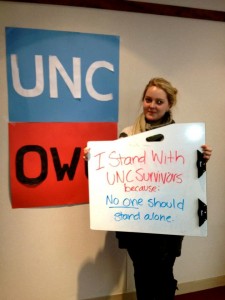
Assistant Copy Editor
OWU students speak out for UNC-CH rape survivors
Several hours after senior Leah Shaeffer heard Landen Gambill, a sophomore at the University of North Carolina at Chapel Hill, is reportedly facing expulsion for speaking publicly about being raped, she got an email from sophomore Liz Nadeau.
Shaeffer is the campus campaign organizer for V-Day – an international movement to end violence against women and girls – at Ohio Wesleyan, and Nadeau is president-elect of Pitch Black, OWU’s women’s a cappella group.
The two worked together to hold a photo shoot for OWU students showing support for Gambill and other sexual assault survivors at UNC-Chapel Hill.
Gambill, along with 66 other survivors at the university, filed a complaint with the U.S. Department of Education’s Office of Civil Rights, alleging the university has violated survivors’ legal rights.
She has since had charges filed against her by her alleged rapist in the university’s student-run Honor Court, who says he’s innocent and that she’s created an intimidating environment for him by speaking publicly about her experience. Gambill has said she filed sexual assault charges against him through the Honor Court and he was found not guilty.
According to Gambill, she was told even saying publicly that she was raped could constitute an Honor Code violation.
Shaeffer said it was important to raise awareness about this issue because “it is so unjust and it is a really terrible and excellent example of rape culture in America, specifically in the university system.”
Nadeau said she felt the incident is “something people needed to know about.”
“She (Gambill) needed the support from other schools, and I felt like it should really be a community issue and not just a UNC issue,” she said.
Holden Thorp, chancellor of UNC-Chapel Hill, was sent questions about the photo shoot and the issue; Susan Hudson, outreach editor of UNC News Services, replied on his behalf.
“Because of concern for our students and their privacy, and in accordance with the Family Educational Rights and Privacy Act (FERPA), we are unable to discuss the specifics of an Honor Court case or related allegations involving students,” she said in an email.
Hudson also forwarded “Message from the Chancellor: Continuing the Campus Conversation about Sexual Assault,” a letter to the UNC-Chapel Hill students, faculty and staff from Chancellor Thorp.
The letter says sexual assault is “one of the greatest challenges facing campuses across the nation,” and that the UNC-Chapel Hill administration welcomes the Office of Civil Right’s investigation.
“Our response will show how the University has made significant changes in the past 18 months about how sexual assault complaints are handled,” Thorp said in the letter.
He said sexual assault cases have been removed from the Honor System’s jurisdiction and that the university is continuing to build on existing relationships with the Public Safety department, local law enforcement and rape crisis counselors.
Nadeau and Shaeffer took photos between Monday, March 4, and Thursday, March 7, and posted them on Facebook on March 8. They are still working on an accompanying video project.
Shaeffer said they decided to do a photo and video project was because it was “the easiest and quickest way” to show as much support as possible for the survivors.
She added that photo projects can involve many people showing their support, while videos are more easily shared because they only require one link, rather than several for a series of photos.
31 students took part in the photo project, including freshman Alanna Spalsbury, senior Claire Panaccia and freshman Hannah Simpson.
Spalsbury, a member of Pitch Black, held a sign reading, “I stand with UNC survivors because: no should be afraid to SPEAK UP!”
She said in an email she wanted to get involved after “seeing how passionate (Nadeau) was about it.”
“I decided to take part in it because I know too many girls who have been sexually assaulted in my life, and they all have had wonderful supports including their friends, family and school,” she said. “So now, with this happening to those women, I can’t imagine the struggle and hardship it is not having that support that the (people) close to me had.”
Panaccia, whose sign read “I stand with UNC survivors because: who’s really the VICTIM here?” said in an email that she learned about the story when a friend mentioned the project to her over lunch.
“I decided to take part in the photo shoot campaign because victim blaming is, I think, one of the most serious road-blocks to gender equality and the feminist movement in this country,” she said. “I was furious that it would penetrate to an administrative level at a university. It really made me appreciate the supportive environment we foster here at OWU, and I wanted to share that support and love with someone who wasn’t getting it at their own university.”
Simpson said in an email that she heard about the issue during a conversation, and found out about the project through its Facebook event.
Her sign read “I stand with UNC survivors because: no one should be punished for defending him or herself.”
“I decided to take part in this campaign because it is important for students at UNC to know that they have our full support,” she said.
“Also, this is an issue that I feel particularly strongly about, and I felt that it was my responsibility to take part in it.”
Nadeau said the main goal of the project was “just to get OWU out there and make sure that they (the survivors at UNC-CH) know that they have the support of a school that’s a thousand miles away.”
She said she hopes students at other campuses will see the photos and carry out similar projects to show their support.
“We’re hoping to inspire other colleges to do their own thing,” Shaeffer said. “We hope that we’ll be one of the first, but definitely not the last.”
—
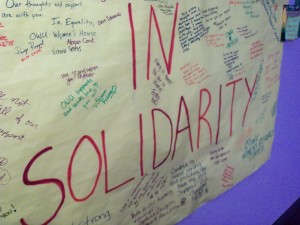 Solidarity for Oberlin minority
Solidarity for Oberlin minority
students facing hate incidents
A sighting of someone wearing Ku Klux Klan robes early in the morning of March 4 outside Oberlin College’s Afrikan Heritage House prompted Ohio Wesleyan students to make a banner showing their support.
The incident was one of many occurrences of racism, homophobia and anti-Semitism reported at Oberlin.
Hate graffiti of slurs like “ni***r” and “fa***t” and drawings of swastikas were seen around campus in February.
Classes were canceled at Oberlin after the KKK incident, which attracted attention from national news media.
At OWU, senior Andrea Kraus partnered with the Office of Multicultural Student Affairs and its director, Terree Stevenson, to hang a banner outside the office and have students sign it in support.
Kraus said she was talking to Stevenson about the situation at Oberlin and wanted to send something to Oberlin to show solidarity, “since Oberlin’s very similar to OWU.”
Kraus said she hopes the banner will make Oberlin students “aware that OWU supports them.”
She marketed the project with a Facebook event and emails to SLU members and leaders of other activist groups.
Junior Lehlohonolo Mosola, resident adviser at the House of Black Culture, signed the banner. He said in an email he hopes the Oberlin administration will “(i)dentify the students responsible as fast as possible and remove them without question.”
Senior Anna Cooper, a resident of the House of Peace and Justice, said one of her best friends is a student at Oberlin and they talked about the incidents over text messages.
“It sounds like students are on edge and scared, and there is a lot of tension between the students and the administration about the level of response,” Cooper said in an email.
Oberlin sophomore Ambre Dromgoole, a member of the Black Student Union there, said in an email that she has had trouble sleeping due to the incident. She said she fears what will happen once attention to the incidents fades and wonders whether increased security on campus will continue.
“Being safe and feeling safe are two completely different concepts,” she said. “…(W)ill that security go away, leaving us vulnerable to physical harm as well as the destruction and defacement of the space that we call home?” Will I ever be able to walk around campus again by myself and will I always have to watch my back? Do I have to keep a pair of tennis shoes with me in case I am chased? The impact that these events and the overall racial climate of Oberlin will be something that I carry with me for the rest of my life.”
A black friend of Dromgoole’s who requested to remain unnamed was walking on campus late at night in February when a man chased her after following her in a white van; she was able to get away safely.
Dromgoole said the March 4 sighting was not the first time Klan paraphernalia was spotted on campus.
Another black Oberlin student who requested anonymity found a KKK poster and white supremacist bumper sticker on her bicycle on March 1.
The poster depicted people in KKK robes and the slogan, “The original boys in the hood” while the bumper sticker showed a hand holding a noose and read, “It’s not illegal to be white…yet.”
A record of these incidents and many others was published online by the Tumblr blog “Oberlin Microaggressions.” The account also published messages of support from Oberlin students and alumni, as well as students at other colleges.
Kraus said the situation made her reflect more on the relationship between students and administrators regarding race, gender and sexual orientation.
“There’s a faction of OWU students who are super passionate about social justice issues, and I know that there are some who are a little bit more unaware of them,” she said. “…I feel that our school is pretty respectful. There is, of course, always these instances that happen – I feel like our school can be homophobic and it can be sexist and it can be racist…I think that we have great administrators here who would be supporting us in ways that are both similar and dissimilar to Oberlin.”
Cooper said these issues are problems “at OWU, in Delaware, in Ohio, (and) everywhere.”
“We do not live in an egalitarian society, so these problems continue to exist,” she said.
Cooper listed organizations like the Women’s and Spectrum Resource Centers, OMSA, PRIDE, Black Men of the Future and Sisters United (SU), as well SLU programming and diversity requirements, as institutions that tackle these issues and raise awareness.
“This discrimination is a result of systemic social inequality that is a battle to address every day,” she said.
Freshman Twanisha Taylor said she found out about the Oberlin incident from an SU event.
She said in an email that she supports the Oberlin students because, as a black woman, she knows what it means to be discriminated against on the bases of ethnicity, gender and religion.
“I hope to give Oberlin the support that they need, and to inform them that they are not fighting this fight alone,” Taylor said. “As small schools in Ohio, we have to stick together so that we can be strong, and continue to encourage each other.”
Dean of Students Kimberlie Goldsberry also signed the banner, which she said had a “tremendous amount of comments of solidarity.”
She said in an email she hopes the incident “reminds us all to value our diverse campus community and that it is the people of OWU that create the community spirit.”
“It is important to respect and value each individual within our community,” she said.
Oberlin junior Eliza Diop, a member of the Oberlin Student Senate and an RA at the Afrikan Heritage House, said in an email that she thought the banner was “a wonderful way to show (OWU’s) support and solidarity for the issues occurring on Oberlin’s campus, but also on several campus(es) throughout our nation.”
The Student Union on Black Awareness and SU also held a banner-signing event to show solidarity with Oberlin students, but leaders of the two groups declined to answer questions about the event.
Mystified and double bound: Alcohol and adulthood in American culture
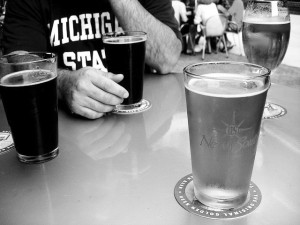 By Noah Manskar
By Noah Manskar
Editor-in-Chief
Alcohol and adulthood are strange bedfellows at the uniquely American institution of the residential university.
With entrance into college—and the departure from home it often necessitates—comes a degree of independence and a select few accompanying privileges. Students thrust themselves out of their parents’ watchful gaze and into a universe where alcohol, the mystical substance of their youth, is readily available. It’s a thrill to be able to make the choice whether to partake, a decision previously reserved for adults.
With this opportunity, however, comes a risk. For at least half of the average Ohio Wesleyan student’s time at the university, it’s still illegal to consume or possess alcohol even when it’s accessible—the law says the legal age is 21, and public and private authorities enforce that law. Despite the independence they have and adult choices they’re able to make, students are still not considered full adults in the eyes of the government.
“The legal threshold that enables young people to engage in adult-like behavior operates as rite of passage,” said Dr. Harry Blatterer, sociology lecturer at MacQuarie University in Sydney, Australia. “Hand in hand with that, legal consumption sends the message to young people that once you cross that threshold you are considered an adult.”
Blatterer’s research specialty is “sociology of the life course,” particularly social constitutions and constructions of youth and adulthood. He has published numerous scholarly articles and a full-length book, “Coming of Age in Times of Uncertainty,” on contemporary adulthood.
According to Blatterer, legal drinking’s tie to adulthood is partly social and partly psychological. In the post-World War II era, when the modern convention of adulthood was formed, the drinking age stood at 21. But successful efforts in the 1960s to lower the voting age affected the drinking age, as well—it became 18, concurrent with the age of conscription.
“You can argue that at a time when the people were needed for the war effort, it made sense to make them feel like they grew up,” Blatterer said.
However, with advances in psychological research and a rise in drunk driving following the change, the age was returned to its former status to protect the public from youthful recklessness and protect youth from themselves.
“We have really internalized the categories of developmental psychology that very strictly categorize the maturity people are supposed to have in their lives,” Blatterer said.
The alcohol-adulthood connection, though, is not universal. Sophomore Ashley Cole said the law and her personal attitudes towards drinking have not formed a bond between the two in her mind.
“I’ve just never measured adulthood by being able to drink, personally,” she said. “…I guess I can see how other people think there’s a relationship. I can see how other people feel mature when they drink. I’ve never really wanted to drink myself. I kind of want to, but when I’m 21, just because that is the law, and if the law was 18, I probably would drink now and then just to try it. But I feel like we just go with what’s allowed and what’s not allowed and don’t really think about the implications, I guess, on maturity.”
Cole grew up in Ashtabula, Ohio, with parents who drank “once in a great while”—there was rarely alcohol in their home, and she was seldom around people who drink until she came to OWU. She said this influenced her choice not to drink until she turns 21, and that she views drinking to excess negatively.
“When it’s just a little bit now and then, I understand, but when people get drunk that’s when I have a problem, because to me, that’s showing that you’re not mature,” she said.
Additionally, developmental psychology isn’t field that has something to say about alcohol’s role in adulthood. According to Karen M. Herrmann, Jungian psychology says alcohol has negative effects on the development of one’s consciousness, as well as the physical brain.
“It makes people unconscious,” she said. “I think the whole process Jung focused on is becoming a unique individual—conscious, changing and expanding.”
Herrmann received her post-graduate degree in analytical psychology from the International School of Analytical Psychology in Zurich, Switzerland; she also studied at the C.G. Jung Institute. She practices in Columbus, Ohio, specializing in spirituality, depression and substance abuse.
According to Herrmann, the Jungian challenge for young people is to develop a balance in habits like alcohol use in order to fully develop one’s consciousness and relationship to the world. This can become difficult when engaging in drinking as a way to “feel connected to their peers.”
“I think the task for a student is to develop their ego and who are they in the world, and it is about testing limits and realizing what’s not healthy and what is,” she said. “But I think if they find their way in the world and get established, it’s later typically what Jung calls the self—it’s a spiritual process where they let go, but they still need their ego.”
According to Tony Buzalka, a senior from Wadsworth, Ohio, the transition from illegal to legal drinking causes a shift in self-perception more than others’ perceptions of one’s adulthood.
“The first couple times you drink legally, you’re like, ‘Oh, I can do this. Look at me, I’m all grown up,’” he said. “But I’d say people around your age also change. They’re like, ‘I can legally drink now. Cool.’ Your parents and other adults just still see you as—I wouldn’t say they necessarily recognize you as an adult. I still think that we’re looked at as still young and pretty immature, especially since a lot of people, when they’re legally able to drink, don’t usually make the correct decisions while drinking.”
When he was underage, Buzalka said, alcohol was “mysterious stuff,” an enigmatic substance vital to having a good time. But coming of age and experiencing its effects broke down those facades.
“It was kind of something that I was supposed to do, and once I turned 21 it kind of lost the mystery,” he said. “There was just kind of a sense of maturing—I don’t need this; it’s just there. I think just the idea of something I’m not supposed to have—I think that affects everyone, the idea of forbidden fruit.”
For senior Ellie Bartz, the legal dividing line between her and alcohol was clear. Growing up in Sterling Heights, Mich., her parents were never particularly restrictive about drinking themselves, but it was implicitly articulated that it would only be acceptable for her to drink after she turned 21.
“I guess it’s kind of one of the last big milestones between being a teenager or being an adolescent, and a responsibility but also a privilege that you now have when you can drink legally,” she said. “The duality between them—it’s a privilege, but it’s also a responsibility, because you have to not—you don’t have to, but you can if you use the privilege—but you’re kind of expected not to.”
—
Freshman Claudia Bauman spent 11 months in Germany with the Rotary Exchange Program after graduating high school in 2011. She lived in Bautzen, a town near Dresden in the former East Germany. The cultural differences she noticed between American and German attitudes about alcohol in her time there were vast.
“Here versus there, in Germany, it’s a lot more—I don’t wanna say encouraged, but accepted,” she said. “Young, young kids start drinking and they just grow up with it. It’s just another part of life, versus here, I feel it’s a whole other world.”
German law says youths can buy beer and wine for themselves at 16 and all other alcoholic products at 18. Bauman said alcohol is introduced to children long before they reach the legal age, and parents often provide them with alcohol.
“13 year-olds-start sipping on beer, 16 year-olds-can buy it themselves, and they’re still at home,” she said. “They learn their limits a lot earlier, and they just have control over it.”
Kate Lewis-Lakin, a junior from Chelsea, Mich., noticed similar differences when she studied abroad in Cork, Ireland, during the fall semester.
“I think it’s just more acceptable, part of the culture, not ever really made to be a bad thing; where I think it is here people do abuse it when they’re in college, younger, and also because it’s not legal until you’re older, it’s a lot more demonized as a bad thing,” she said.
Lewis-Lakin said Ireland’s drinking culture is “something they are proud of.” Beer brewing is widely practiced, and the nation’s stouts—dark beers made from malt or barley and hops with an alcohol content of 7 percent to 8 percent—are its darling craft. Because of this, both natives and foreigners invariably flock to pubs.
“Pubs are gathering places, and you are really not expected to drink in a pub if you really don’t want to, especially on a weeknight; but they are the places where people gather together,” Lewis-Lakin said.
Emily Slee, a freshman from Melbourne, Australia—where the drinking age is 18—has experienced the stricter American values toward alcohol as well as the more liberal Australian attitudes. She was born in Melbourne, moved to the U.S. around age 4 or 5, and then back to Australia for high school; her parents currently live in the states.
She said because her mother is American, she is generally reluctant to skirt the legal drinking age and serve her a glass of wine with dinner, but her Australian father is less hesitant because of the Australian attitude.
“I know a lot of Australians are a lot more laid back, so they kind of have a very blasé attitude towards it, and I know that in my family particularly—or just America in general—you tend to see more of the conservative side,” she said.
It was hard for Slee to relinquish the ability to drink legally when she returned to the U.S. for college. She said the lack of independence in getting herself alcohol to consume casually makes her feel less mature. To her, the discrepancy is “a bit silly.”
“It’s frustrating,” she said. “I don’t mean to sound like an alcoholic, because I’m not, but it’s more of the fact that if you want go have a drink with friends or if you want to just drink casually with your parents, you just can’t.”
Lewis-Lakin also found it difficult to have national borders affect her status as a legal drinker. She was well over the Republic of Ireland’s legal age of 18 during her four months in Cork, the country’s second-largest city, but she still has another year before she can order a stout with a meal in the United States.
“(T)hat’s just annoying, because I am a responsible drinker…and just the fact that I’m not able to drink in a restaurant here frustrates me, and that’s just based on the year I was born versus any sort of experience or anything like that,” she said.
In American law and culture, the age of 21 is the point at which people are deemed instantly ready, physically and socially, to consume alcohol. In contrast to Germany, Ireland and Australia, there is no gradual phasing-in of alcohol into one’s life.
According to Mainza Moono, a freshman from Lusaka, Zambia, this attitude is also different from the convention on the African continent. Moono said he chooses not to drink, but has observed how people use alcohol in American and African culture.
“I think for us, the ‘you’re ready’ time—there’s no line,” he said. “You’re ready when you think you’re ready. But I feel it’s something you baby-step into. You slowly start doing it—it’s not like, ‘Tonight I’m starting to drink, I’m going to get wasted.’ That’s how it would be for the first time for a high school student, whereas for us it would be, ‘Tonight I’m drinking, I’m gonna have one beer, that’s it. Next week, maybe I’ll have one and a half, or I’ll try wine next week.’”
Bauman said the German tradition is similar, but alcohol is presumed to be a part of the eventual adult’s life. This allows people to understand how alcohol affects them earlier on so they can learn how to safely consume it. This stands in contrast to the American practice of presumably having none until age 21, and then taking full advantage of the new drinking privilege.
“(Y)ou start off drinking little by little—sips as a child to maybe a glass of wine or half a beer—slowly progressing forward,” Bauman said. “When here, a lot of people, their first experiences with alcohol, they don’t just have a sip; it’s more than that. They slowly build up just a tolerance, let alone knowing how much they like to drink or how much they can drink, what type of alcohols agree with their bodies versus not, what can mix—they know all that stuff by age 17, 18.”
According to Bauman, the more steady transition into alcohol use develops a higher sense of responsibility around it in German culture. She said the people she met there were “a lot less rowdy when they drink” than their American counterparts.
“There were a lot of parties I was at where people were like, ‘Oh my gosh, I’ve got to be careful cause I’m drunk and I can’t make a mess, cause otherwise somebody else is going to have to clean it up,’” she said. “Or if they make a mess, they immediately start to clean it up themselves, when you don’t see that as much here—more run away from it. They’re just so responsible for so many different things.”
Moono said alcohol necessitates an elevated responsibility in African culture, as well. It’s escalated even further by the fact that going to a party or club where alcohol is served means driving, and driving means keeping consumption at a safe level.
“So even the extent to which you drink—it doesn’t mean you’re free,” he said. “…But the fact that you’re in someone else’s car means that you have to exercise some responsibility as well, cause you have the luxury of being able to go out.”
—
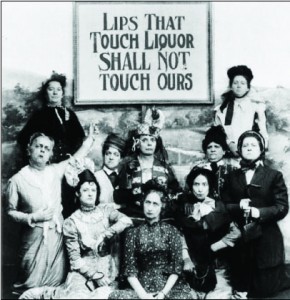
A 1912 photograph of temperance advocates displaying the slogan of the Anti-Saloon League, a 20th century prohibition lobby group. The League worked alongside other groups, like the Women’s Christian Temperance Union, to pass the 18th Amendment in 1920.
But when Blatterer was a boy in Austria, he would sit with his father in pubs from the time he was eight years old. This early exposure to alcohol and what it did gave him an idea very different from many American youth.
“For me growing up as a child, first of all I saw that adults, when they drank too much, just became boring,” he said. “So that kind of means that I didn’t develop a fascination with alcohol, but it also demystifies this notion that alcohol is something very special.”
Blatterer said he thinks this “cultural prohibition” leads many young people to seek it out before they reach the legal age. Once they turn 21, then, they’ve overcome their initial fascination with alcohol.
“So we classically see what we call binge drinking—consumption of large amounts of alcohol—and that’s classically an Anglo-American idea,” he said. “The prohibition backfires, basically. On the one hand it’s saying it’s dangerous, but on the other it’s saying it’s something very special.”
OWU senior Buzalka said he thinks the media’s portrayal of drinking, especially in a college context, makes American youth think alcohol has a power to enhance social situations. He said peer pressure contributes, too—even without direct badgering to consume alcohol, there’s still an implicit assumption that those who abstain are “misfit(s).”
“It makes people kind of put it on a pedestal and makes it seem like everything’s going to be better—social situations are going be great when you’re drinking, and you’re going be more popular cause you’re drinking,” he said. “But once you’re 21 and you’re able to drink whenever you want and no one else has control over it, I think it’s a big thing, just to—I guess you see it for what it really is.”
Bartz, another OWU senior, said alcohol’s cultural mystification affected her ideation of how she would celebrate turning 21—since the event represents a conferring of great privilege, she expected it to feel more significant than it turned out to be.
“(I)t made it seem like it was this big, epic deal, and going to the bar for my 21st birthday and ordering a drink was the most chill thing in the world,” she said. “…And that was really strange for me, because I felt like it was going be this big—not life-altering moment, but just this big moment, and it really wasn’t. It was just me and my friend and the bartender and the four other people who were there.”
Cole, a sophomore, said she thinks some cultural demarcations of when certain behavior are “arbitrary,” but understands the restriction on alcohol. Perhaps the drinking age could be lowered to 18, she said, but to go any lower would be to tread into dangerous social and behavioral territory.
“I think it’s good that kids in high school can’t, except maybe the seniors that are 18, because you’re still trying to figure out life, what’s going on, like dating and boys—all that stuff,” she said. “I see why adults want to keep it away, but they’re really not able to anyways.”
To junior Lewis-Lakin, rearing children to have moderate attitudes about alcohol is as crucial as effecting policy. She said she thinks allowing children to occasionally experience alcohol gives them a “good foundation” for beneficial drinking habits. Or, as her parents did, they could simply exhibit healthy, moderate habits for their children to follow.
“I just think it’s important for parents to model healthy drinking behavior for their children, whether or not they drink with them,” she said. “I think that was definitely a big thing that I did get from my parents, because they enjoy alcohol, but aren’t crazy about it. So that just set me up to have good drinking, so I think parents, guardians, whatever they may be—it’s as important to model that as it is to maybe change the law.”
Even if the law were to change, Bartz questions whether the mystification would ever disappear. She’s confident it wouldn’t.
“I feel like the mystification is still going to follow it, because whatever age you put it at, it seems like that’s the age you get to and you’re an adult, and people will trust you and respect you, and that’s not necessarily true,” she said.
—
To Blatterer, American attitudes toward alcohol are just one contributor to a system of double binds into which Western societies force youth. It’s often considered normal for young people to act out, and they’re often encouraged to take advantage of their age by doing things adults couldn’t get away with. But at the same time, they’re judged negatively as a “cohort” for acting irresponsibly and immaturely, while adults are never judged as a group for the irregular actions of an individual.
“The experience of a young person is a difficult one, because there’s such a tension between being good and making the most of your young years,” he said. “…That doesn’t mean there aren’t people out there that live extremely straight lives, but if you look at how culture in general creates young people, they’re supposed to be acting out…And then we go and we blame them for it.”
Additionally, according to Blatterer, adults are encouraged to be responsible and stable, even though they have the legal privilege of being able to do things like drink. Bartz said she’s experienced this particular bind since she turned 21—despite the risk of underage drinking, the added financial and social responsibilities of being an adult make it less fun.
“I think I drink the same amount as I used to; I just think about it more,” she said. “Which is weird, because I thought about it a lot when I had to figure out where I was getting it. But I think about it more, I think, now that I’m able to do it for myself—‘Do I have time for this? Can I actually support this for whenever I’m doing it?’”
OWU freshman Bauman said her conversations with international students in the Rotary Exchange Program led her to conclude that the U.S. is a sort of Western anomaly when it comes to alcohol. Of around 30 peers, only three from China and Japan had the sort of “negative association” with alcohol found in America.
“It really is you just have to do everything when you’re young, do as much as you can, but alcohol has to wait,” she said. “And then once you have alcohol, you can experience all the same things again, but then with drinking.”
Moono, a sophomore, said the double bind of youth is actively avoided in Africa—young people are judged based on individual actions rather than generalizations about the entire demographic, so there’s no scapegoat for irresponsibility. Additionally, “recklessness” is often associated with poverty, which encourages “educated people” like college students to act responsibly.
“I think just generally speaking in the African continent and Zambia, that reckless youth thing is not something that your parents or you want to have surround you,” he said. “So when someone is talking about you, that generalization doesn’t exist for the most part. It only exists on an individual basis.”
For Buzalka, youthful recklessness paved the way to adult responsibility. He was put on legal probation for a year following an underage drinking citation he received three months before his 21st birthday. He’s also had law enforcement make fun of him for admitting to being underage when he called emergency services to aid a friend; one officer teased him for having narcolepsy.
Despite these negative experiences, Buzalka said he’s grateful for the lessons he’s learned. He doesn’t drink to excess as frequently, and he focuses more on having fun sober instead of needing alcohol to do so. His brushes with American cultural and legal boundaries surrounding alcohol have taught him the importance of “growing from failure,” a principle he’s carried into his academic and social lives.
“I really like the ideas of how I look at alcohol now, and I personally think they’re responsible and more mature, and I wouldn’t have those ideas if I didn’t have the bad experiences with alcohol,” he said. “If every experience was a great experience, it would be nothing to learn from.”
Artists shine in All-Student Spring Show
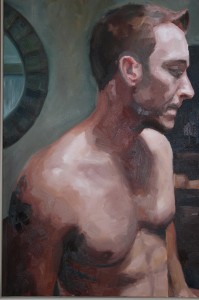
Transcript Correspondent
Different types of art are on display in the lobby of Beeghly Library for the annual Spring Art Show, where many students’ works are presented for the whole Ohio Wesleyan community to see.
The show contains a variety of media including sculptures, paintings, drawings and jewelry. Over 150 pieces were submitted to the show, but only 59 were selected to be on display.
Junior Hazel Barrera has two pieces in the show: a pair of earrings and a necklace. Barrera said she does not have a concentration in her fine arts major, but she does enjoy working with metals and was happy that her work is being shown.
This is Barrera’s second time in the show, and she is impressed by this year’s show.
“I really like the setup,” Barrera said. “It is amazing how every artist gets to help put up the show and the outcome it’s always fabulous, and we also get to know other people outside our concentrations.”
Junior Ha Le has two pieces featured in this year’s show as well. One is a metals piece called “Phoenix,” and the other is a charcoal drawing of her grandmother called “Grandma.”
Le’s fine arts focuses are drawing, painting and printmaking.
Le said she was also excited to be selected for the show and s that she is hoping to win something for her work.
“It’s a bit smaller than last year’s show,” she said. “The jurors this year seem to be pretty strict, but the show still looks great. We have a variety of medium, scale and subject matter.”
Senior Paige Phillips also has pieces featured in the show, which take on a different medium than others that are displayed.
She has two hand-made books displayed; one is case-bound and the other is Japanese-bound.
Phillips focuses on drawing, graphic design and computer imaging.
“I was excited when I found out I got two pieces selected for the spring show because the jurors were artists and professors from other schools, so you can’t really judge what type or style of artwork they will like,” she said.
Phillips was also happy about how her pieces turned out.
She said there is always something she could do to change a piece slightly, but overall she was happy with them.
The show started on March 4 and will continue through April 4.
Basketball remains united as a team despite tournament loss
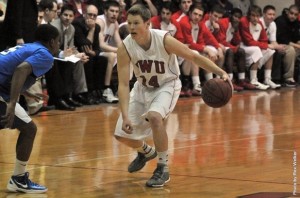
Transcript Correspondent
The Ohio Wesleyan men’s basketball teams’ season came to an end on March 9 in the second round of the tournament at the hands of Cabrini College with a score of 84-81. The Bishops went into the NCAA tournament with a regular season record of 22-5; they ended up finishing with a record of 23-6.
Their season record tallied the second most wins in school history and a personal best for Head Coach Mike DeWitt. Senior guard Andy Winters said a key to the team’s success this season and their run in the tournament was their chemistry.
“We are very close as a team,” Winters said. “We hang out all the time on and off the court and that is something that is special to have.”
Junior guard Taylor Rieger agreed with Winters and said their chemistry on and off the court was a big part of their success this season.
Senior post Billy Reilich said the team’s “cohesiveness” has also been instrumental in its achievements.
“It seems like everyone understands their roles and is perfectly okay playing them, we give each other advice and know how to take it just as well as give it,” Reilich said. “We trust each other unlike any team I’ve ever been on. It’s unreal.”
The team hosted their first round game of tournament against St. Vincent on March 2, which they won 84-75. During the first half the score remained close, and going into half time the score was tied 36-36. However, in the second half the team came together as a whole to pull away from St. Vincent.
The Bishop bench stepped up their game, adding 20 points down the stretch. Winters ended the game with 22 points and a team high of four assists. Rieger followed with 16 points and three assists, and senior Marshall Morris had a game high 11 rebounds.
Senior guard Eric Easley said the unity of the team and their “hard work” in practice led to their success against St. Vincent. Following their win against St. Vincent the Bishops hosted the second round tournament game against Cabrini.
Going into the game on March 9 the Bishops had been on a seven-game win streak. The first half of the game remained close all throughout with the Bishops leading at half-time with a score of 39-37.
The two teams rallied back and forth in the second half as each team made several scoring runs. The Bishop offense was led by Winters, junior guard Dre White and freshman post Claude Gray.
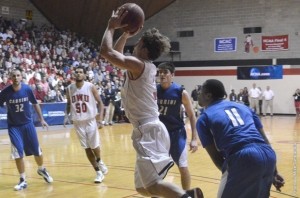
“In the game of basketball, scoring runs are inevitable,” Winters said. “Good teams are going to make a run and it becomes a possession-by-possession game. They happened to make a few more plays.”
The Bishops were able to keep the second half close until the final buzzer. Cabrini came back from the two-point deficit to win the game in the last minute with final score of 84-81.
While many fans were upset with officiating during the final minutes of the game, Winters said the team was able to recover from the calls.
“We needed to adjust and I believe we did for the most part,” Winters said. “We had a chance to win and go into overtime and that’s all you can ask for.”
Winters led the way in point for the men’s team with 22 points and six assists. Rieger would finish the game with 15 points, and Reuel Rogers grabbed a team-high nine rebounds.
Winter’s said the team was upset to see their successful season come to an end, but they were proud of all that they had accomplished.
“I can’t thank OWU enough for the experience I had on and off the court,” Winters said. “Everyone was so supportive and that is what makes OWU a special place to play.
“These eight seniors had a great career at OWU and we all expect big things from the classes to come. We will miss it but it is time to move on. I’m sure I can speak for all the seniors when I say ‘Thank you, OWU.’”
Relay’s Luminaria Ceremony to commemorate cancer struggles
By Rachel Vinciguerra
Transcript Correspondent
Tomorrow night students and faculty will come together for the Luminaria Ceremony during Colleges Against Cancer’s (CAC) Relay for Life event in memory and honor of those on campus who have been affected by cancer.
Sophomore Kate Hudson, public relations chair of CAC, said that Relay for Life is an organized community that walks a track overnight to fundraise for cancer research and awareness. The Luminaria Ceremony is one part of this larger event.
“The Luminaria Ceremony takes place after dark,” Hudson said. “We can remember people we have lost to cancer, honor people who have fought cancer in the past, and support those whose fight continues.”
Hudson said candles will be lit at 10 p.m. on Friday night inside personalized bags in honor of cancer victims. She said these bags serve as “glowing tributes” to those affected by cancer.
Hudson said there were 226 students participating as of Sunday, March 17, but the number continues to increase. She said she still remembers her experience at the ceremony last year and looks forward to this year’s event.
In the OWU Daily, those involved in the Luminaria Ceremony were encouraged to submit photographs of loved ones in a holiday setting, consistent with Relay for Life’s theme.
Junior Caroline Block-Williams said she decided to participate in the ceremony to honor her mother, who passed away last year after her battle with Crohn’s Disease and the diagnosis of cancer in her small intestine.
“Not a second goes by that I do not think of her and I cannot think of a better way to honor her,” Block-Williams said. “She would love to know that people are coming together to fight for something that is the cause of thousands of deaths per year.”
Block-Williams said her mother Lydia, the director of learning resources and faculty development coordinator for the Sagan Academic Resource Center, struggled with Crohn’s disease for 45 years.
In 2009 she was diagnosed with cancer in her small intestine and the many rounds of chemotherapy she endured were incredibly harsh on her body.
“Overall, the combination of cancer and Crohn’s disease led to her passing on June 22, 2011,” she said. “She never wanted anyone to know how sick she really was; however, it is imperative for events like Relay for Life to be arranged to understand how these diseases affect people’s daily lives.”
Sophomore Suzanne Pappenhagen said she lost her friend Liz to leukemia in high school.
Pappenhagen said Liz was diagnosed with bone cancer in eighth grade and, after going in and out of remission over the next few years, discovered she had developed leukemia from one of the medications she had taken. Pappenhagen said Liz remained strong throughout the process.
“No parent should lose a child the way Liz’s parents lost her,” she said. “But Liz never lost her smile and was and is an inspiration to many.”
Pappenhagen said Relay for Life and the Luminaria Ceremony touch anyone who has been impacted by cancer.
“Relay For Life is not only an important fundraiser to help end cancer, but a way for survivors and friends and family of people who have passed away to bond together to make an active difference,” she said.
Block-Williams said the camaraderie is an important part of the reason she decided to participate in the Luminaria Ceremony and Relay for Life this year.
“I am participating to receive support from my fellow peers as well as to provide support for those who have lost a close one or are experience a close one battling cancer,” she said.
Senior Amanda Boehme said she is participating in the Luminaria Ceremony in honor of her high school friend Ben, who passed away from cancer this year.
“He was a wonderful spirit who brought happiness to everyone’s lives through his creativity and his energetic attitude,” she said. “He impacted so many lives—including mine—so I wanted him to be acknowledged this year at Relay for Life.”
Boehme said it was hard watching as cancer took away some of the things that she and her friends had always associated with Ben, like his long hair.
“Ironically he donated to cancer patients a few years ago,” she said. “He sadly lost his hair going through chemotherapy.”
Boehme said she remembers Ben going to the doctor’s office every few weeks and enduring much physical pain and suffering throughout the process.
Despite this, she said, he kept a remarkably positive attitude throughout the process.
Boehme and Pappengagen said the Luminaria Ceremony in particular can remind participants they are not alone in what they have dealt with.
“It fuels our spirit to continue the fight against cancer,” Boehme said.
Block-Williams said she felt the ceremony was very significant on campus for that reason.
“I think this ceremony is extremely important to honor the people in our lives who we have lost due to these horrible diseases,” she said. “I can only hope that a cure for at least some types of cancer will be found during my lifetime.”
The Luminaria Ceremony will take place Friday, March 22, at 10 p.m. as a part of the Relay for Life event, which will be happening from 6 p.m. on March 22 to 11 a.m. on March 23.






